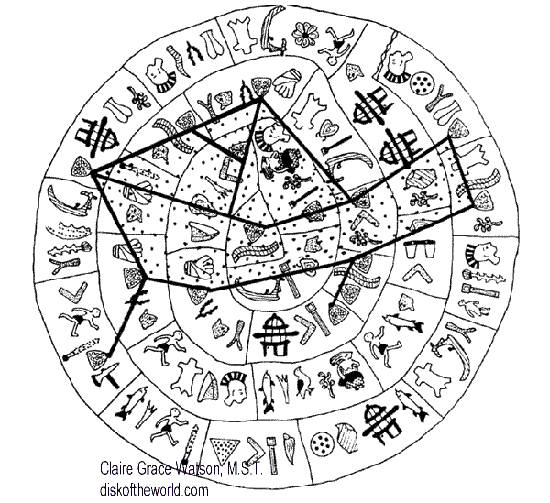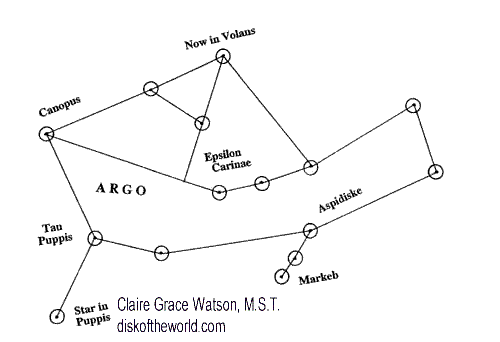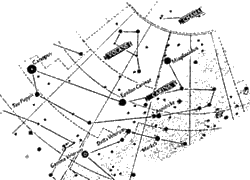Unpacking and publishing the Phaistos Disk since 1993
HOME | PREVIOUS | NEXT | SITEMAP
  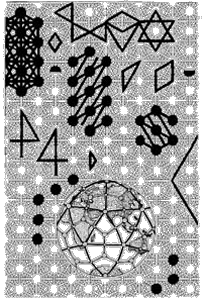 |
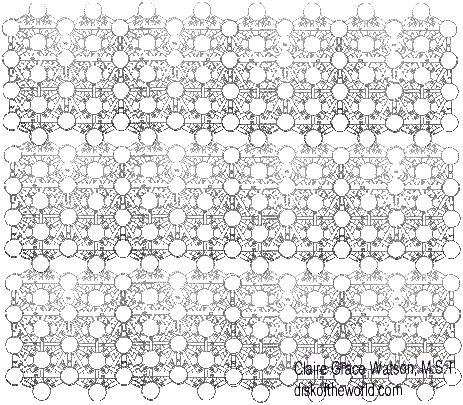

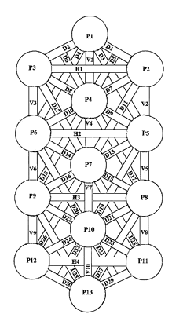
The starting point is the top square where Theseus and Ariadne are leaving the boat to enter the Maze of Daedalus. The goal is the Minotaur's square at the center of the maze and Portal 4, P4, on the glyph (representing, as discussed in Forms and Archetypes of the World Soul, the curtain of space-time and energy-matter). Several World Soul glyphs joined together represent a continuum. Drag these Kabala Trees together and join them at the spheres to make the continuum. Overlap several spheres to see the natual holographic effect.
Looking back at square one, where the lovers Theseus and Ariadne are entering the maze, notice they are entering behind a curious creature, a white dwarf that is diving in ahead of them. He is significant. The legs of the dwarf are in the shape of a 4, the first of six 4's in this puzzle, indicating their destination is P4. The dwarf is positioned upside-down like The Hanged Man of tarot.
The tarot deck is key to the resolution of the maze, perhaps offering proof of the existence and use of tarot 1100 years before the oldest surviving 15th c. CE deck. Familiarity with the Rider-Waite tarot deck is helpful to the solution of the maze because the artist of the maze seems to reference tarot and because the Rider-Waite deck was designed by members of the Hermetic Order of the Golden Dawn, an order that is the apparent repository of ancient Egyptian Hermeticism. Tarot cards are supposed to have originated in ancient Egypt with the Osiris sect. Both the maze mosaic and the Phaistos Disk will help validate this belief.
The maze mosaic appears to be a surface, or that which has length and breadth only. This is illusory, as it has depth as well. A comparison of the mosaic with the glyph representing the curtain of space-time and energy-matter (your creation above) reveals this third dimension. The narrative device of continuous representation, in which an objective "now" does not exist, provides the 4th dimension of time.
The crook and scourge of Hermeticism are analogous to the right and left pillars of the curtain (and also the right and left pillars of Solomon's Temple). The crook and scourge surround the central pillar of the curtain and represent the balance between Mercy (the crook and positive right pillar) and Severity (the scourge and negative left pillar). By these correspondences then, the entrance into the maze is along V1, the central pillar.
Diving deeper now, to gain more meaning still...Osiris with crook and scourge is seen on the altar of the Hermetic Order of the Golden Dawn (above right), symbolizing Sirius in the center of the heavens amid the seven planets. This particular design represents part of the revealment of the Phaistos Disk.
The second clue to the entrance into the maze is provided by the large Tau crosses (alchemical meaning--As Above, So Below) at the bottom of the maze mosaic. Just above the large Tau crosses are big squares, and above the big Tau cross, far right, is a big square showing in miniature the top of the maze as it would appear if P1 (top sphere on the World Soul glyph) were not intersecting H1. When P1 is lowered to H1, P4 is lowered out of position exactly between P5 and P6 (second spheres down on the right and left), where we see it on the maze mosaic. This miniature of the maze is a reversed number 4 meaning, in mysticism, "open channel." This refers to the open channel of V1 and to the open channel of the portal in the curtain of space-time and energy-matter.
The Tau crosses provide the third clue. When the right arm of the horizontal bar of the Tau cross is removed, an upside-down reversed "L" appears, the Hebrew letter Daleth meaning The Door. The numerological equivalent of this letter, Daleth, is the number 4. The Door (portal, Porta Lucis, light door, stargate) is the intersection of P1-H1 (P1 is the top sphere and H1 is the first horizontal bar down from it). Two tiny squares break the Tau cross pattern just beneath the boat square and mark the parameters of The Door. This is the domain of The Empress of tarot, Hebrew letter attribute Daleth. In mysticism she is the curtain guarding the portal; she is the entrance to the physical world. Her portal is a two-way door to the central pillar (V1) of space-time and energy-matter. She rules the Limit between the physical world and the Mundus Archetypus.
Turning now to the palace at Knossos (left), and diving still deeper for meaning, Theseus and Ariadne entered the maze at P1. This is the front door of the palace at Knossos, marked by "A," where is located a geophysical portal corresponding to the inner world portal. This corresponds to the entrance point of Light-Power at the top of the head (the soft spot), designated the fontanelle in modern shamanism and the crown chakra in Hinduism. We are showing a correlation of the journey of Theseus and Ariadne into the palace and the journey of the spirit through the fontanelle. (This is deep, isn't it? This material is multidimensional, so it can seem like slow going. But keep going -- it is well worth it!) Once inside the maze, the couple continued along V1, a long plumbing pipe beneath the hallway of the palace, to P4 beneath Central Court, where Theseus encountered the Minotaur.
When the battle of Theseus and the Minotaur ensued beneath the palace at Knossos, Ariadne walked upward from P4 through the maze, trailing the Thread of Love behind her for Theseus to follow. The path of the thread can now be identified as an uninterrupted path from a starting point--P4-to a goal-P5--where Ariadne waits.
The deeper meaning of Ariadne relates to the role of the High Priestess of tarot and of Ariadne-Isis-Sothis. They symbolize the memories carried in the unconscious mind, and we can see this symbology as a kind of clue as to how the maze mosaic was conceived. The High Priestesses bridge the abyss and access the Universal Mind wherein is contained the knowledge of what is, what has been and what shall be. The essence of the High Priestess is water, and her open channel is the stream of consciousness. She is Path 13 (V1), numerologically 4, the path that connects P1 (Source) to P4 (Truth). The Hebrew letter attribute of the High Priestess is Gimel, meaning camel--the water bearer. "And of the stars they consider Sirius to be Isis's--as being a water-bringer." (4)
The long line of High Priestesses forms a caravan of camels traveling across the ages, with the line of descent leading from Isis to Ariadne to the maze mosaic artist to this writer and to others.
At the Isis level of representation, the white dwarf diving from the boat is Diktys, the nursling of Isis who fell head-first out of the celestial boat or baris of Isis and into the Nile River and was drowned, in trying to catch onions with his hands.(5) The onion, layer upon layer, is the maze-vortex-portal, and Diktys is seen on the maze mosaic diving for the big onion--the Maze of Daedalus. Egyptian priests gave this part of the Osirian mythology a literal interpretation and refused to eat onions! (6)
As Theseus encounters the Minotaur, Isis-as-Ariadne is seated in the palace of Knossos on the bottom steps of the stairs to the Royal Apartments, the stairs beside "A" on the enlarged detail of the ground plan. (below left) The Royal Apartments are coded "B" on the illustration of the palace ground plan. (above) 3,600 years ago, Ariadne sat on these stairs (below) and waited for her new lover to finish the Minotaur or be finished by him.
Now ensues the "bitter combat of the two natures," represented by Theseus (human-heroic) and the Minotaur (human-beastly). Theseus vanquishes the Minotaur and follows Ariadne's Thread of Love upward through the maze to ground level, to converge with her in P5. Together, they walk through the portal seen at the back center of the image (above), and enter Central Court. They cross over Central Court to P6 via H2, the invisible parallel plane of existence horizontally layering the maze.
At P6 is a wheel cross atop a monolith, part of the hydraulic engineering system of the palace. They turn the wheel and release the water through the pipes and the drains and float the Minotaur along the Central Pillar out of the palace and into the river (of the stream of consciousness or the universal mind).
Theseus and Ariadne board the ship and sail away on the beautiful blue Aegean, leaving us plenty to think about. As the ship in P1 sails from the rocky shores of Crete, P1, P4 and P7 are lifted back into their proper positions, exactly center the portals of the outer pillars. Theseus and Ariadne sailed to the isle of Naxos, according to legend, but perhaps they first visited Egypt and Cheops. From a different perspective it can be seen that Theseus and the Minotaur, at the center of the maze-vortex, are also at the bottom, center, of the truncated Great Pyramid of Cheops. (Now do you see the hidden dimension of depth?) This intriguing development leads us to Egypt and Cheops by way of the Phaistos Disk of Bronze Age Crete. We turn now to the disk for clarification of these Cretan-Egyptian-Osirian mysteries. But to finish the story of Theseus and Ariadne. When they arrived at Naxos Theseus proved to be fickle and abandoned her there. Dionysus (the Greek equivalent of Osiris, husband of Isis) fell in love with her and crowned her a queen of heaven, which she well deserved for her efforts on behalf of her country and her lover!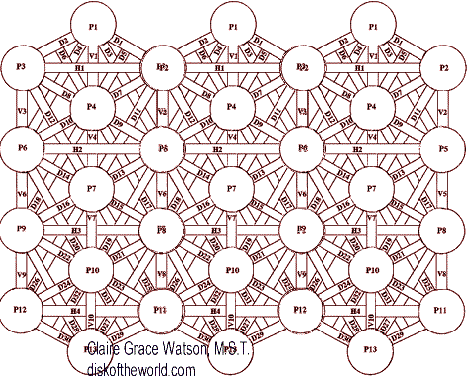
![]()
 Following Ariadne's tarot thread now, we find that the Hebrew letter attribute of The Hanged Man is Mem, meaning water, and the numerological attribute is 40 or 4. The Hanged Man symbolizes the dive into the unconscious mind on an inner journey to the interior of the self, to arrive at the understanding of the nature of consciousness--and for the moment we will accept this as the purpose of our journey.
Following Ariadne's tarot thread now, we find that the Hebrew letter attribute of The Hanged Man is Mem, meaning water, and the numerological attribute is 40 or 4. The Hanged Man symbolizes the dive into the unconscious mind on an inner journey to the interior of the self, to arrive at the understanding of the nature of consciousness--and for the moment we will accept this as the purpose of our journey.
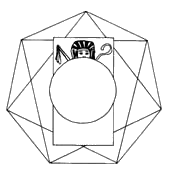 The dive into the maze is the entry, as indicated by three clues provided by the artist(s) who created this incredible puzzle. The dive is along the uninterrupted, straight-down-the-middle path of Vertical 1 (V1), which is just beneath P1 (see the Kabala Tree above for the numbered spheres and paths referenced here). Theseus, who is subduing the Minotaur with a scourge, provides the first clue to this entry into the maze. Theseus also carries a crook. Look back at the boat square. He is shown in the boat square with a crook. Look at the Minotaur square. He is flailing the Minotaur with a scourge. The crook and scourge are symbols of Osiris, the god-king named for the star Sirius. Osiris holds the crook and scourge (above right), the ancient Egyptian symbols of the Three Primordial Principles (good or light, evil or dark and intermediate or transcendent), which is part of a geometry-based number philosophy wide-spread during the time discussed here (Maze of Daedalus mosaic, 3000 BCE and 4th c. CE). This number philosophy is covered later on.
The dive into the maze is the entry, as indicated by three clues provided by the artist(s) who created this incredible puzzle. The dive is along the uninterrupted, straight-down-the-middle path of Vertical 1 (V1), which is just beneath P1 (see the Kabala Tree above for the numbered spheres and paths referenced here). Theseus, who is subduing the Minotaur with a scourge, provides the first clue to this entry into the maze. Theseus also carries a crook. Look back at the boat square. He is shown in the boat square with a crook. Look at the Minotaur square. He is flailing the Minotaur with a scourge. The crook and scourge are symbols of Osiris, the god-king named for the star Sirius. Osiris holds the crook and scourge (above right), the ancient Egyptian symbols of the Three Primordial Principles (good or light, evil or dark and intermediate or transcendent), which is part of a geometry-based number philosophy wide-spread during the time discussed here (Maze of Daedalus mosaic, 3000 BCE and 4th c. CE). This number philosophy is covered later on.
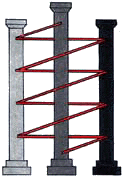 The Three Primordial Principles, as expressed by the philosophy of the ancient world, represents civilization's first perceptions of electromagnetism and positive-negative polarity. The Three Primordial Principles are said to be the cause of the creation of the universe, which came into being as a result of the interplay between the two opposing principles (Yin-Yang in Chinese mysticism) and the Intermediate principle of unity or negation (the neutron in physics). The Three Primordial Principles at work in the creation of the universe is demonstrated by the three pillars of the curtain of space-time and energy-matter (left) at work in the formation of the vortex and physical world. The vortex-portals in the curtain of space-time and energy-matter--physicality in other words--keep us separate but hold us together at the same time.
The Three Primordial Principles, as expressed by the philosophy of the ancient world, represents civilization's first perceptions of electromagnetism and positive-negative polarity. The Three Primordial Principles are said to be the cause of the creation of the universe, which came into being as a result of the interplay between the two opposing principles (Yin-Yang in Chinese mysticism) and the Intermediate principle of unity or negation (the neutron in physics). The Three Primordial Principles at work in the creation of the universe is demonstrated by the three pillars of the curtain of space-time and energy-matter (left) at work in the formation of the vortex and physical world. The vortex-portals in the curtain of space-time and energy-matter--physicality in other words--keep us separate but hold us together at the same time.


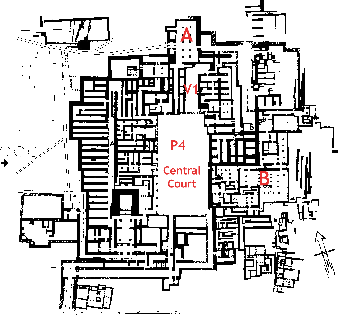
 Upon reaching P5 she grounded the ball of thread, which is the circle and semicircle directly in front of her on the inside of the small Tau crosses. Because she is on a plane or a level of existence with P5, as shown on the curtain of space-time and energy-matter (see World Soul glyph), she entered the isolated square by simply stepping over the Tau crosses, the ellipse of the maze, the pipes and the drains of the palace, and into the square where she sat down on the stairs and waited.
Upon reaching P5 she grounded the ball of thread, which is the circle and semicircle directly in front of her on the inside of the small Tau crosses. Because she is on a plane or a level of existence with P5, as shown on the curtain of space-time and energy-matter (see World Soul glyph), she entered the isolated square by simply stepping over the Tau crosses, the ellipse of the maze, the pipes and the drains of the palace, and into the square where she sat down on the stairs and waited.
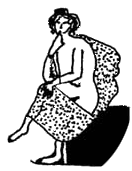
 Diving deeper for the identity of Ariadne, she is the nude woman on The Star card of tarot, the star being Sirius. She is the seminude woman on The World card. In this respect she is Isis Unveiled and Isis-Sothis, the High Priestess of Thoth and of tarot. Sothis is the ancient Greek name for Sirius, which the Egyptians called Sopdu. The Unveiled Isis-Sothis symbolizes the lifted curtain. Both Isis of tarot and Ariadne wear only a cloth covering the abdomen; both are encircled by an ellipse; and both cross their legs in the shape of a number 4, meaning open channel. The Hebrew letter attribute of The World card is Tav (Tau), meaning cross, and the numerological attribute is 400, or 4. This references the open channel amid the Tau crosses.
Diving deeper for the identity of Ariadne, she is the nude woman on The Star card of tarot, the star being Sirius. She is the seminude woman on The World card. In this respect she is Isis Unveiled and Isis-Sothis, the High Priestess of Thoth and of tarot. Sothis is the ancient Greek name for Sirius, which the Egyptians called Sopdu. The Unveiled Isis-Sothis symbolizes the lifted curtain. Both Isis of tarot and Ariadne wear only a cloth covering the abdomen; both are encircled by an ellipse; and both cross their legs in the shape of a number 4, meaning open channel. The Hebrew letter attribute of The World card is Tav (Tau), meaning cross, and the numerological attribute is 400, or 4. This references the open channel amid the Tau crosses.
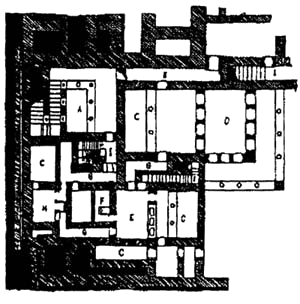
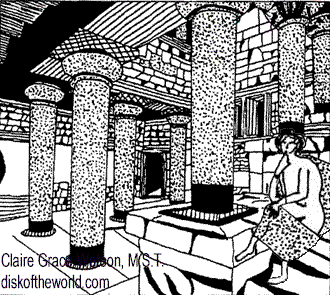
Each of the [Seven] Planetary Spheres is a complete World containing a number of divine offspring, which are invisible to us, and over all of these Spheres the Star (Sirius) we see is the ruler.(4)
The round shield to the right of the Hermetic Star contains the Ring Cosmos and Ring Chaos of Ring-Pass-Not (limits the spread of the fiery cosmos) and symbolizes the Limit of the Hebdomad, the material universe of the 7 lower spheres or planets. The Hebdomad is represented on the curtain of space-time and energy-matter by the lower 7 portals (spheres). The two outer shields of the Vitriol Acrostic contain alchemical symbols in the form of mythical beasts connected by chains. They symbolize the planets as being "living creatures having bodies fastened by vital chains," (5) which hold them to the "appointed task of their orbits."
The "divine offspring" of the planets (see the quote) are nonmaterial spheres or spiritual levels of planetary existence. Around the edge of the Riddle of the Stone, which has been associated with the Emerald Table of Hermes Trismegistus (covered later on), is a Shamanic message meaning "visit the inward parts of earth; by rectifying thou shalt find the hidden [Philosopher's] Stone." The creator of the Riddle was Basil Valentine, the mysterious 16th century alchemist believed to have been a Benedictine monk.
Alchemical enigmas such as the Riddle of the Stone are common and are meant to convey secret information to those initiated into the mysteries. A famous text enigma created by the mysterious alchemist The Cosmopolite involves the 7 planets and supplies a link in the chain connecting the Riddle of the Stone, the curtain of space-time and energy-matter, and the shields of the Phaistos Disk. The Cosmopolite's text makes little sense without the information from modern Hermeticism (6) enabling the diagram of the planetary positions onto the portals of the curtain of space-time and energy-matter. (below right) The Cosmopolite will now speak:
Look at the sky and the spheres of the planets. You will see that Saturn is the highest of all, succeeded by Jupiter and then by Mars, the Sun, Venus, Mercury and finally the Moon. Consider now that the virtues of the planets do not ascend, but descend. Experience itself teaches us that Mars can easily be converted into Venus, but not Venus into Mars--Venus being a lower sphere. Similarly Jupiter is easily transmuted into Mercury, because Jupiter is higher than Mercury. The former is the second below the firmament, the latter second above the earth. Saturn is the highest, the moon the lowest. The sun mixes with all of them, but is never improved by the inferior ones. Further you will note that there is a great correspondence between Saturn and the Moon, with the Sun midway between them. There is also a correspondence between Mercury and Jupiter and between Mars and Venus. In the midst of all is the Sun. (7)
Concealed on the Phaistos Disk is the singular image of the 7 planets surrounding the fixed star of Sirius. This image is revealed by the placing a point at each symbolic shield (below) and connecting all but one of the points with lines. By this method, a star inside a heptagram emerges. The outside edge of the Phaistos Disk is traced around the heptagram design because the points inside the shields are encircled. A shield is placed at each point to show the exact location of the shields on the disk. Revealed is the star Sirius with its companion star, Sirius B. Double every line and the point representing the companion becomes connected.
Concealed on the Phaistos Disk is the original Hermetic Star, the emblem of the ancient Egyptian Hermeticists.
In the Egyptian sense, it is SIRIUS the Dog-Star, the Star of Isis-Sothis. Around it are the Stars of the Seven Planets each with its seven-fold counterchanged operation. (8)
This design has come down to us through time and is demonstrated on these images from modern Hermeticism. (below)
Top left, Keys in the Enochian Language by John Dee (16th c. CE) click on image for larger view; second from left, Osiris altar, Hermetic Order of the Golden Dawn, 20th c.; third from left, ceiling of the tomb of Christian Rosenkreuz, 18th c. CE, Roscicrucian; right, floor of the tomb of Christian Rosenkreuz, 18th c. CE, Roscicrucian; bottom left, Keys in the Enochian language, geometry design, bottom right, Hermetic Star of the Phaistos Disk.
By all these correspondences we can arrive at the decipherment of the hand shields As the decipherment of the Phaistos Disk will show, the ancient Egyptian Osiris sect of the priests and priestesses of Thoth were engaged in their mystery religion deep inside Cheops, the "house" that may be marked by the "E" of the Phaistos Disk. In subjective-nonordinary reality, the Master of the Secret House is Thoth--Divine Mind--and the Secret House in the inner cosmos is the counterpart to the sacred house in the physical, exterior world. In subjective-nonordinary reality, the curtain of physicality can be lifted and a portal created by the deliberate technique of meditating the Hermetic Star design of the Phaistos Disk as well as by working with the individual pictographs. They all have magical properties because they are based upon universal archetypes.
The ancient Egyptian religion was"one of the most grandiose religions of the Universe,"(10) "the deepest and most fascinating mystery of antiquity." (11) Thoth, the Master of Wisdom and Truth and the personification of the Mind of God (12) (Mind and Idea) (13) established the priests and priestesses of Isis and Osiris. It is Thoth who is the Master of the Secret House. In later accounts of him Thoth is Mercurius-Hermes Trismegistus, the legendary scholar who "taught mankind the arts of civilization after which 'he mounted to the stars.'" (14)
The entire mystery-myth of ancient Egypt, the events in the supernal and symbolic lives of Isis and Osiris, of Horus, Typhon, Nephthys and Anubis, are seen on the Phaistos Disk. This great Egyptian Religion of the Mind, the beginning of the Emanationist philosophical system in Egypt, was widespread and "virtually supreme at one time in popular Hellenistic circles." (15) It is only natural, then, and very fortunate, to find in Crete, 1600 years prior to the "popular Hellenistic circles" referenced above, and 1600 years after the religion's broad inception, a complete accounting of the mystery-myth of Isis and Osiris. On the disk we find a myth in transformation from Egyptian expression to Greek expression. Further, the disk and the myth may fingerprint alien participation in early Earth civilizations.
The mystery of the Osirians is recorded by Plutarch (46? CE - 120? CE), the Greek biographer and essayist, in his treatise "On Isis and Osiris." Plutarch, who was an initiate in the Isis-Osiris mystery religion (as is this writer), faithfully recorded the story but kept secret its meaning, offering little explanation for any part of it because initiates, historically, were sworn to secrecy. The Isis-Osiris religion centered on Sirius in Canis Major and featured the god-man Osiris-Sirius and his sister-wife the goddess Isis-Sothis (Isis-Sirius).
Now, to the myth itself...In the beginning Hermes (Thoth) and Rhea, the Father-Mother, were in love, and within Rhea's Womb life began to form. Inside Rhea's Womb--the Mighty Whirlpool and Vast Vortex of the infinite, symbolized perhaps by the spirals on both sides of the Phaistos Disk--all was "motion pure and simple, unordered or chaotic." (16)
Thoth (also Kronos or Time) introduced order into Rhea--creating space-time--and she gave birth to Osiris (Mind and Idea or Thoth's Image), and "a voice (Logos) fell out together with him on his being brought forth-to wit: 'The Lord of all comes forth to light'" (17) His birth was heralded:"Great King Good-doing Osiris is born." (18) After Osiris was born, out came his brother Aroueris, the Elder Horus, which was a prophetic birth foretelling the Horus (Cosmos or Energy) that was to come.
After Aroueris was born, the evil Typhon (Matter) leapt forth most unnaturally (because he preempted Isis or Nature) from the rib in Rhea's side. Isis (Nature or World Soul) was born next and then Nephthys. Before they were born, and because they were in love, Isis and Osiris (Soul and Mind) married, as did Typhon (Matter) and Nephthys (End) but they hated each other. Nephthys or End is the end of the emanations of Thoth and Rhea. In this Egyptian expression of Dualism or the Doctrine of Two Contraries, good Osiris and bad Typhon emanated from the same Source because "'reciprocal' is cosmos' harmony." (19)
There could not be apart good things and bad, but there's a blend of both so as to make things fair. (20)
Or, rather, seeing that Nature produces nothing, generally speaking, unmixed down here, it is not that from two jars a single mixer, like a tavern-keeper, pouring things out like drinks, mixes them up for us, but that from two opposite principles and two antagonistic powers--the one leading [things] to the right on the straight [road], the other upsetting and undoing [them]--both life has been made mixed, and cosmos (if not the whole, at any rate this [cosmos] which surrounds the earth and comes after the Moon) irregular and variable, and susceptible of changes of every kind. (21)
"Osiris is Sun and is called Sirius by Greeks." (22) "For they write the King and Lord, Osiris, with 'eye' and '.'" (23) Osiris orders the universe. His name is derived from "sairein," meaning "sweep clean," in order to beautify and adorn." (24) And they say that when Osiris was king, he straightway set free the Egyptians from a life from which they could find no way out and like unto that of wild beasts, both setting fruits Good King Osiris as Mind and Idea empowered to participate in the give and take of creation went forth over the whole earth, cleaning it, Osiris "went forth over the whole earth, sailing the Heaven-Ocean in the Argo. (below) At the prow of the Argo is the pilot, the star 'Kanobus' (Canopus), or 'Pilot'--from whom, they say, the star got its name." (27) Osiris is the General and Kanobus is the Pilot. (28) The Argo is drawn by connecting together the tips of the triangle fruit (or stars) distributed by Osiris. If the symbol represents star, then the meaning seems to be that Osiris is credited with distributing the stars in the heavens.
And [they say] that the ship which Greeks call Argo is an image of the bark of Osiris, constellated in his honour, and that it sails not far from Orion and Dog, the former of which Egyptians consider the sacred [boat] of Horus and the latter of Isis. (Plutarch)
![]() On Side 1 of the disk (above top) are 6 arrows (left) resembling the 32 arrows on the maze mosaic. Tracing paper is placed over Side 1, a point is placed at the position of each arrow, and the points are then connected with lines. The Great Pyramid of Cheops emerges (below), with its 4 planes converging at the vertex.
On Side 1 of the disk (above top) are 6 arrows (left) resembling the 32 arrows on the maze mosaic. Tracing paper is placed over Side 1, a point is placed at the position of each arrow, and the points are then connected with lines. The Great Pyramid of Cheops emerges (below), with its 4 planes converging at the vertex.
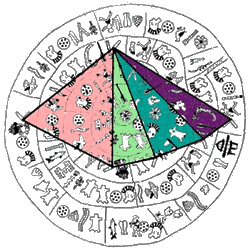 The arrows represent Cheops.
The arrows represent Cheops. ![]()
 By this connect-the-dots method can be derived other recognizable and exciting patterns. On Side 1 of the disk are 15 round shields, each containing 7 dots.
By this connect-the-dots method can be derived other recognizable and exciting patterns. On Side 1 of the disk are 15 round shields, each containing 7 dots.
 A man is holding one of the shields in his hand, defining them as hand shields. In this symbolic 4-way convergence, the name "Pacal," (Mayan king Lord Pacal) means "hand shield;" an anagram of the name of the mysterious alchemist Fulcanelli is "l'ecu finale," meaning "the final shield;" and by placing Sides 1 and 2 of the disk together, as indicated by the matching line segments on the outer shells of each side, the famous Figure 8 shield of ancient Crete is produced. (below right)
A man is holding one of the shields in his hand, defining them as hand shields. In this symbolic 4-way convergence, the name "Pacal," (Mayan king Lord Pacal) means "hand shield;" an anagram of the name of the mysterious alchemist Fulcanelli is "l'ecu finale," meaning "the final shield;" and by placing Sides 1 and 2 of the disk together, as indicated by the matching line segments on the outer shells of each side, the famous Figure 8 shield of ancient Crete is produced. (below right)

 The 7 dots within the shields of the disk form a hexagon like the hexagons of the curtain of space-time and energy-matter which compares favorably with the Figure 8 shields. The dots inside the shields represent the 7 planets known at that time, including the sun and the moon and excluding Earth; they are Saturn, Jupiter, Mars, Mercury and Venus. A round shield identical to those of the Phaistos Disk is seen on the Riddle of the Stone, also known as the Vitriol Acrostic (below), which alchemists, after the 16th century, held in superstitious reverence.(1) (The Vitriol Acrostic may be the alchemical descendant of the ancient frescoes of the Atum-cult period in Egypt which show "the sun sending forth rays, each furnished with a hand for giving and blessing." (2) Alchemy began in Egypt, which was once called Chemmis. "They call Egypt Chemia," (3) or Chem-Egypt, hence Alchemy.)
The 7 dots within the shields of the disk form a hexagon like the hexagons of the curtain of space-time and energy-matter which compares favorably with the Figure 8 shields. The dots inside the shields represent the 7 planets known at that time, including the sun and the moon and excluding Earth; they are Saturn, Jupiter, Mars, Mercury and Venus. A round shield identical to those of the Phaistos Disk is seen on the Riddle of the Stone, also known as the Vitriol Acrostic (below), which alchemists, after the 16th century, held in superstitious reverence.(1) (The Vitriol Acrostic may be the alchemical descendant of the ancient frescoes of the Atum-cult period in Egypt which show "the sun sending forth rays, each furnished with a hand for giving and blessing." (2) Alchemy began in Egypt, which was once called Chemmis. "They call Egypt Chemia," (3) or Chem-Egypt, hence Alchemy.)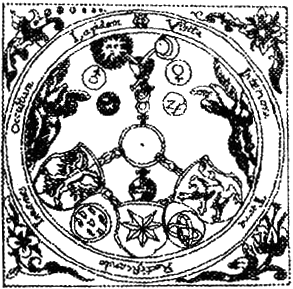 On the Riddle of the Stone (left. Illus. 1) are various symbols for the 7 planets. Top left are 7 small circles representing the 7 planets; top center are 7 symbols, one for each planet; and at the bottom are various shields. Identical to the shields on the disk is the round shield, bottom left, within which are 7 dots of hexagonal arrangement representing the 7 planets. To the right of this shield is the 7-pointed Hermetic Star, each of the 7 points representing one of the 7 planets.
On the Riddle of the Stone (left. Illus. 1) are various symbols for the 7 planets. Top left are 7 small circles representing the 7 planets; top center are 7 symbols, one for each planet; and at the bottom are various shields. Identical to the shields on the disk is the round shield, bottom left, within which are 7 dots of hexagonal arrangement representing the 7 planets. To the right of this shield is the 7-pointed Hermetic Star, each of the 7 points representing one of the 7 planets.
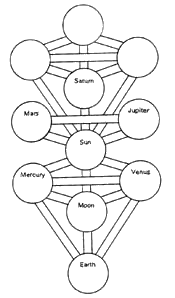
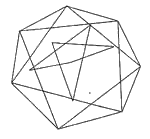
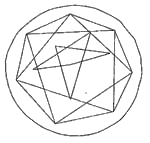
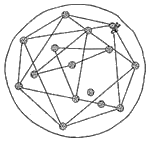
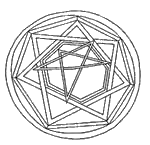
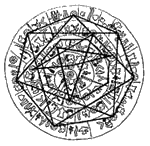
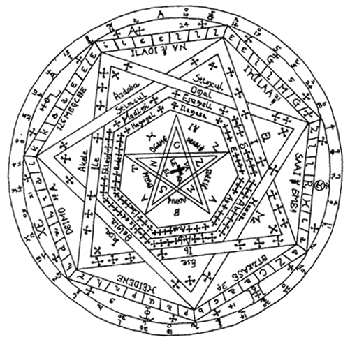

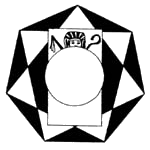
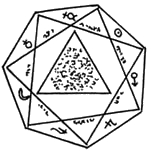
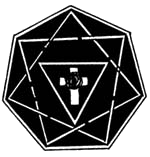

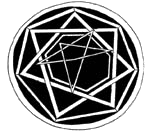
 of the Phaistos Disk. They represent the visible universe of the 7 planets. Therefore, the man holding the shield, the warrior and god-king Osiris, is a god--a being larger than the visible universe.
of the Phaistos Disk. They represent the visible universe of the 7 planets. Therefore, the man holding the shield, the warrior and god-king Osiris, is a god--a being larger than the visible universe.
 "E" is the ancient Sumerian symbol for "House" and means house of the god (like church, synagogue, temple, etc.), and this common use of "E" demonstrates a cultural diffusion. The "Egyptian Book of the Dead" was known to the Egyptian priests as "The Book of the Master of the Secret House", this house meaning the great pyramid, otherwise called "Light." (9)
"E" is the ancient Sumerian symbol for "House" and means house of the god (like church, synagogue, temple, etc.), and this common use of "E" demonstrates a cultural diffusion. The "Egyptian Book of the Dead" was known to the Egyptian priests as "The Book of the Master of the Secret House", this house meaning the great pyramid, otherwise called "Light." (9)
![]() The sceptre of Osiris appears 4 times on Side 2; 5 times on Side 1.
The sceptre of Osiris appears 4 times on Side 2; 5 times on Side 1.
 This sign appears once on Side 1.
This sign appears once on Side 1.
![]() The sweep of Osiris, which doubles as a scourge (see Theseus at the center of the maze mosaic) appears 4 times on Side 1.
The sweep of Osiris, which doubles as a scourge (see Theseus at the center of the maze mosaic) appears 4 times on Side 1.
![]() before them, and laying down laws, and teaching them to honour the Gods. (25) This triangle fruit that Osiris set before the Egyptians appears 15 times on Side 2, 3 times on Side 1. (The triangle fruit is the fruit of the triangle or geometry, i.e. knowledge or gnosis, which sets one free. This symbol may also represent the honey cake of Osiris or even a honey jar. It may also be a symbol for star.)
before them, and laying down laws, and teaching them to honour the Gods. (25) This triangle fruit that Osiris set before the Egyptians appears 15 times on Side 2, 3 times on Side 1. (The triangle fruit is the fruit of the triangle or geometry, i.e. knowledge or gnosis, which sets one free. This symbol may also represent the honey cake of Osiris or even a honey jar. It may also be a symbol for star.)

![]() not in the least requiring arms, but drawing the multitude to himself by charming them with persuasion and reason, with song and every art he Muses give... (26) Osiris as heaven-walker going over the whole earth appears 5 times on Side 2; 6 times on Side 1.
not in the least requiring arms, but drawing the multitude to himself by charming them with persuasion and reason, with song and every art he Muses give... (26) Osiris as heaven-walker going over the whole earth appears 5 times on Side 2; 6 times on Side 1.
